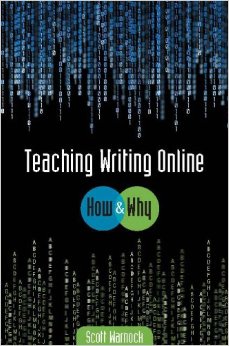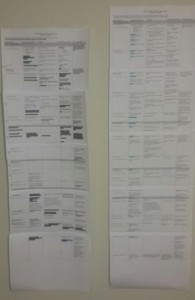Welcome to “Reflections from the Trenches in the Cloud,” a new series here that continues our December chat on online instruction and e-portfolios and our January webtext on Hacking the Classroom. Over the next couple of months, I’ll be offering fresh reflections on my recent arrival in online writing instruction.
Although I had six years of college writing instructional experience, beginning to teach online reminded me of entering the classroom for the first time. In my first semester of classroom teaching, I had to concentrate on everything that needed to happen in the class. I made notes about everything from taking attendance to offering reminders about the next class’s work. In moving to the online class, I similarly needed to learn new pedagogical strategies and I had to deliberate about decisions that had become second nature in my classroom instruction.

In Teaching Writing Online, experienced online writing professor Scott Warnock proposes that online writing courses are especially promising, an “evolution of sorts in writing instruction,” because of their ability to “offer opportunities to teach beyond the normal constraints of geographic and temporal borders” (x). While Warnock here is addressing in part how students can take classes when and where they need to, I want to explore in this reflection how I found the online class encountered more flexing of temporal borders than students’ scheduling preferences. First, I’ll touch on some of the temporal impacts to course development and delivery, primarily from the instructor’s perspective.
Preparation. Although I’d taught this particular college writing course for years, my preparations to teach it online started early. While I’d attended online instruction panels at the Conference on Higher Education Pedagogy, once I found I would be teaching online I went to every panel addressing online writing instruction I could at CCCC and Computers and Writing. On campus, I took part in an intensive faculty workshop on transitioning to online instruction. An experienced faculty member advised that it took a year to develop a one-semester course for the online environment. Whether the instructor is developing material alone or receiving developmental assistance from campus instructional or distance learning support impacts this development time.

Syllabus. Warnock offers the guideline that the online writing syllabus should be more detailed than onsite syllabi (38). Instead of thinking in terms of the usual 150 minutes of meetings with homework two or three times a week, I had to rethink my instruction into plans organized for a week of work. The transition paralleled the switch between teaching MWF to TH classes, or vice versa, but I found I had to think about the week’s materials cohering more as a single unit than an arc with two or three focal points per class meeting. The calendar portion of my syllabus looks different as a result of the online week, something that required planning and design, particularly as I’d become accustomed to the MWF or TH formats.
Videos. I decided to create videos for my online writing instruction. Even though they’re all under 15 minutes, my course videos take much longer to make than that. While I’d always spent time planning any course presentation materials, I sometimes found myself wistful for presenting it once in front of the class rather than re-recording (and often re-re-re-recording) because I stumbled over words or found a better image or presentational strategy to incorporate. I had to acknowledge that while I always did the best I could, I simply couldn’t produce television-ready videos without my own production team on hand.

LMS. It inevitably takes much longer to do anything on my Learning Management System than I expect. While I’ve always used by LMS in teaching face-to-face classes, I spend that much more time in my LMS as an online writing instructor. The process of uploading to and configuring materials on my LMS always takes longer than I want. This isn’t necessarily the fault of my particular LMS–it certainly takes longer to upload course videos to YouTube than I’d like–but it’s a temporal impact that needs to be accounted for.
Time zone. For the first time in seriousness, I had to associate time zones with assignment due dates and times to account for distance learners. Remembering to add that felt a lot like needing to remember to put “call roll” on my early lesson plans.
Logistics. Things that don’t take long in the classroom can take longer in the fully asynchronous online environment. Certain activities, like peer review and conference signups, are accomplished in the face-to-face classroom with a quick passing around of a sheet of paper or the “exchange papers with the person on your left in your group.” None of these are insurmountable problems online, but they do require some instructor thinking up front to mitigate confusion and to identify an appropriate implementation strategy.
While those are temporal considerations for instructor preparation, in addition to Warnock’s identification of student freedom to take online courses when and where they want, I also found other temporal benefits for my students.
Pacing. One of my favorite things about the online writing class is that students write when they can and take the length of time appropriate for them. Online, they are in charge of their writing. While in the face-to-face class, I try to monitor and gauge how students are proceeding with in-class writing and other activities, but inevitably a few students end up getting rushed and a few are sitting waiting for follow-up discussion. In an online writing course, students are in control of how long they spend writing and then they can enter the discussion.
Student Writing Time. My students get to write at times they choose. I see my students writing at all times of the day. With the online class, class writing isn’t confined to 9:30-10:45 am TH EST.
Time Travel. Warnock argues that the online writing course is not just different, but is a progressive approach to the teaching of writing because students write so much as part of the online writing course, in ways that are both informal and developmental and to communicate (xi). Indeed, much of my student’s process work is stored in the LMS. Their weekly assignments build toward their unit culminating assignments; they can go back to prior work to build the culminating project. For their end of unit and end of semester reflections, students can go back into the LMS’s repository of their prior writing and their classmates’ feedback for evidence in analyzing their processes and progress.
Those are some of the major temporal differences I’ve noticed between online and face-to-face classes. I’d love to get your feedback in the comments on differences you have found in your online teaching or online writing studies.
Works Cited
Warnock, Scott. Teaching Writing Online: Why and How. Urbana, IL: NCTE, 2009.
